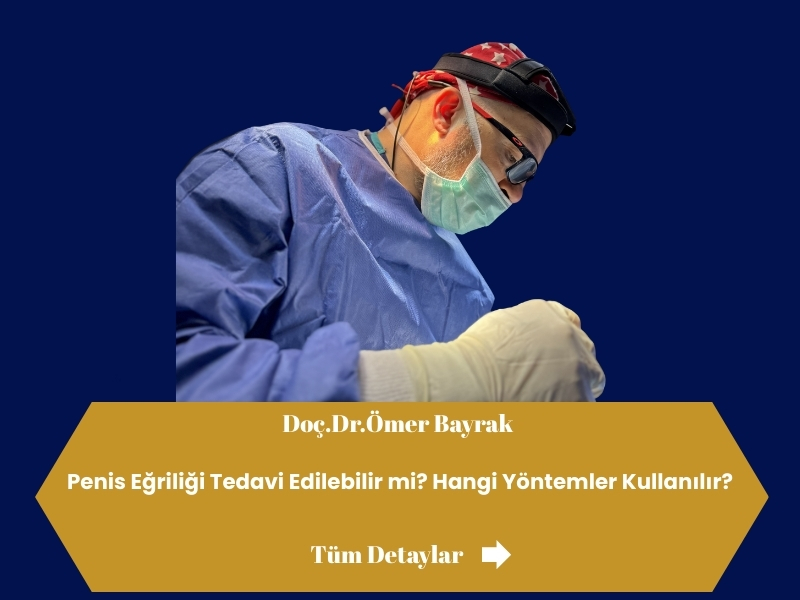Curvature of the penis, medically known as Peyronie’s disease is a condition known as penile curvature, which causes deformity due to hard plaques that form in the penile tissue. When the curvature is mild, it may not interfere with sexual intercourse, but in advanced cases it can cause pain, erectile dysfunction and difficulty during intercourse. Today, penile curvature can be treated with different methods ranging from early drug and injection treatments to surgical correction operations. Intervention at the right time provides both functional and aesthetically satisfying results.
Early Treatment Options for Penis Curvature
Penis curvaturegoes through a process known as the “active phase”, especially during the first 6-12 months. During this period, the curvature may progress slowly, pain may be felt during erection and hard plaques may start to form on the penis. Early treatment is of great importance both to stop the progression of the curvature and to reduce pain.
The main treatment methods applied in the early period are as follows:
- Medication: Oral medications or local applications used under the supervision of a doctor can slow down plaque formation.
- Injection treatments: Special enzymes or medications injected into the plaque soften the hard tissue and help reduce the curvature.
- Shock wave therapy (ESWT): Low-intensity sound waves are used to strengthen the vascular structure and soften plaque tissue.
- Mechanical stretching or traction devices: With regular use, it increases the flexibility of the penis and can reduce the degree of curvature.
These early treatments can often give satisfactory results without the need for surgery. However, determining the most appropriate method for each patient is possible only after a detailed examination and evaluation by a urologist.
Conditions Requiring Surgical Intervention
Surgical intervention in penile curvature usually comes to the agenda in advanced cases where satisfactory results cannot be obtained despite medication, injection or mechanical treatments. Surgery is performed both to correct the curvature and to enable the patient to regain sexual function.
The main conditions requiring surgical treatment are as follows:
- Advanced curvature: Curvatures that physically prevent sexual intercourse.
- Cases associated with erectile dysfunction: In cases accompanied by erectile dysfunction, penile prosthesis treatment can be applied together with surgery.
- Rapidly progressive deformity: Increased curvature in a short period of time and penile deformity becomes apparent.
- Failure to respond to other treatments: Failure to achieve results from early drug, injection or device treatments.
Surgical options include penile shortening (plication) surgery, lengthening (grafting) surgery and penile prosthesis implantation. Which method is preferred is determined by the degree of curvature, the length of the penis, the erectile condition and the patient’s expectations. Proper care and rehabilitation after surgery is critical for long-term success.
Modern and Minimally Invasive Treatment Methods
Modern and minimally invasive treatment methods for penile curvature aim to correct the curvature or stop its progression without the need for surgery. These methods are generally preferred in early and moderate cases and are characterized by a short recovery period.
The main modern treatment methods are as follows:
- Injection therapies into the plaque: Special enzymes or drugs are injected directly into the hard plaque tissue to soften and stretch it.
- Shock wave therapy (ESWT): Low-intensity sound waves are used to strengthen the vasculature, reduce pain and target plaque tissue.
- Mechanical traction devices: With regular use, the length of the penis is maintained and the degree of curvature can be reduced.
- Topical treatments: Some forms of topically applied medication can help slow the development of plaque.
These methods generally maintain patient comfort, have a low risk of serious complications and allow a quick return to daily life. However, the most appropriate treatment plan for each patient should be determined by the urologist, taking into account the degree and duration of the curvature and other accompanying health problems.
Recovery Process and Success Rates After Treatment
Penis curvature treatmentThe recovery period after treatment varies depending on the method used and the general health condition of the patient. In minimally invasive treatments, the patient can usually return to his/her daily life the same day or the next day, while the recovery period after surgical interventions can take up to several weeks. During this period, the care instructions recommended by the doctor should be strictly followed to promote wound healing and reduce edema and pain.
Things to consider during the healing process:
- Abstaining from sexual intercourse in the first weeks
Regular dressing and observing hygiene rules- Timely use of exercises or traction devices recommended by the doctor
- Keeping control appointments
Success rates vary according to the treatment method and the degree of curvature. While the success rate is between 60-80% in minimally invasive treatments initiated in the early period, satisfactory results of over 90% can be obtained with surgical methods applied in advanced cases. In cases with erectile dysfunction accompanied by penile prosthesis treatment, high patient satisfaction is achieved both functionally and aesthetically.
The correct treatment plan, regular follow-up and patient compliance are the most important factors that guarantee long-term success.

